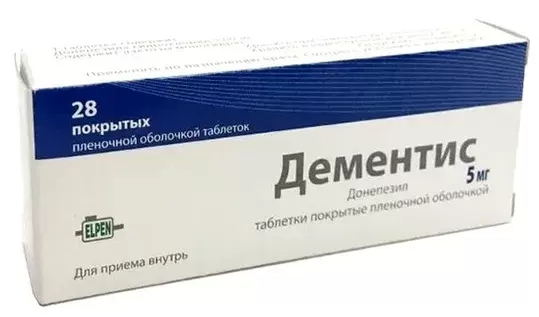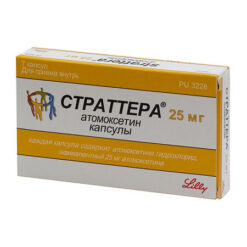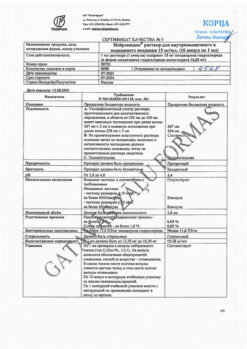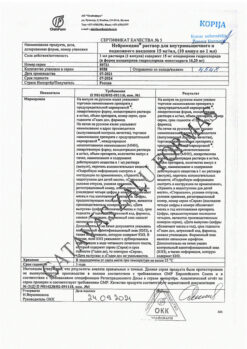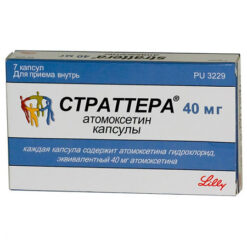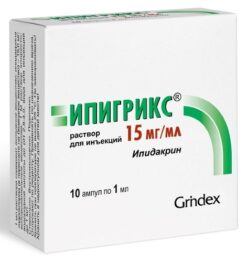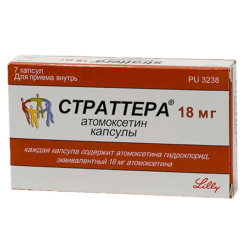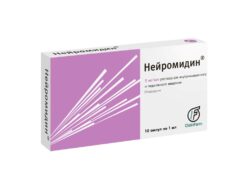No products in the cart.
Dementis, 5 mg 28 pcs.
€48.12 €40.72
Description
Pharmacological group: Cholinesterase inhibitor.
Pharmacodynamics
Donepezil is a selective, reversible inhibitor of the enzyme acetylcholinesterase, which is the predominant type of cholinesterase in the brain. In vitro, donepezil inhibits this enzyme more than 1,000 times stronger than butyrylcholinesterase, an enzyme that is mainly located outside the central nervous system.
Inhibiting cholinesterase in the brain, donepezil blocks the breakdown of acetylcholine, which carries out excitation transmission in the central nervous system (CNS). After a single dose of donepezil at doses of 5 mg or 10 mg, the degree of inhibition of acetylcholinesterase activity (evaluated on the red blood cell membrane model) was 63.6% and 77.3%, respectively. Inhibition of acetylcholinesterase in erythrocytes by donepezil correlates with changes in ADAS-cog scale (Alzheimer’s disease cognitive assessment scale). The ability of donepezil hydrochloride to change the course of concomitant neurological changes has not been investigated. Thus, donepezil cannot be considered to affect disease progression.
Pharmacokinetics
Intake
The maximum plasma concentration (Cmax) of donepezil is reached approximately 3-4 hours after oral administration. Plasma concentration and area under the concentration-time curve (AUC) increase in proportion to dose. The half-life of the T1/2 is approximately 70 hours, so systematic use of single doses leads to a stable concentration that is reached within approximately 3 weeks after the start of therapy. The equilibrium plasma concentration of donepezil and its associated pharmacodynamic effects vary very little during the day. Food intake has no effect on the absorption of donepezil.
Distribution
About 95% of donepezil is bound to plasma proteins. There is no information about the binding to plasma proteins of its active metabolite 6-Q-desmethyl donepezil. The distribution of donepezil in various body tissues has not been studied sufficiently. In distribution studies on healthy male volunteers, it was found that after a single dose of 5 mg of 14C-labeled donepezil hydrochloride, approximately 28% of the dose was detected in the body 240 hours after administration. This indicates that donepezil and/or its metabolites may persist in the body for more than 10 days.
Metabolism and excretion
Donepezil is excreted by the kidneys both unchanged and in the form of numerous metabolites formed by cytochrome P450 enzymes, not all of which have been identified. After a single dose of 5 mg of 14C-labeled donepezil hydrochloride, the plasma concentration of unchanged donepezil is 30% of the administered dose, that of 6-O-desmethyl donepezil – 11% (the only metabolite, with similar activity to donepezil hydrochloride), donepezil-cis-N-oxide 9%, 5-O-desmethyl-donepezil 7%, and 5O-desmethyl-donepezil glucuronide conjugate ‑3%. Approximately 57% of the administered dose was found in the urine (17% unchanged) and 14.5% in the feces, concluding that biotransformation and excretion by the kidneys was the primary route of elimination. There are no data to support enterohepatic recirculation of donepezil and/or its metabolites.
The elimination half-life of donepezil is approximately 70 h.
Gender, ethnicity and smoking have no significant effect on the plasma concentration of donepezil. The pharmacokinetics of donepezil has not been formally studied in healthy elderly or in patients with Alzheimer’s type dementia or vascular dementia. However, the mean plasma concentration of donepezil in these patients was consistent with that determined in healthy volunteers.
In patients with mild to moderate hepatic impairment, elevated equilibrium plasma concentrations of donepezil may be observed.
Indications
Indications
Symptomatic treatment of dementia of Alzheimer’s type of mild to moderate severity.
Active ingredient
Active ingredient
Donepezil
Composition
Composition
1 tablet contains:
Active ingredient:
Donepezil hydrochloride (Cipla Ltd, India) 5.00 mg
Excipients:
Lactose monohydrate 91.75 mg, corn starch 20.00 mg, microcrystalline cellulose 15.00 mg, hydroxypropyl cellulose 3.00 mg, magnesium stearate 0.25 mg (tablet core weight 135.00 mg); shell (Sepifilm 752 white): Hypromellose 2.00 mg, microcrystalline cellulose 1.60 mg, macrogoal stearate 0.40 mg, titanium dioxide E171 1.00 mg (theoretical weight 140.00 mg).
How to take, the dosage
How to take, the dosage
Ingestion.
Take in the evening (before going to bed) with enough water (100 ml).
Adults/Elderly
The initial dose is 5 mg once daily (at bedtime). The dose of 5 mg/day should be taken for at least 1 month until equilibrium plasma concentrations of donepezil are achieved and clinical effect is evaluated. After 1 month, if necessary, the dose can be increased to 10 mg once daily.
The maximum daily dose is 10 mg. The duration of therapy is determined by the physician.
If the next dose is missed, the next dose is taken at the usual time (do not take two doses at the same time). If the drug is missed repeatedly (a break of more than 1 week), you should contact your doctor.
The treatment should be prescribed and carried out by a specialist experienced in managing patients with Alzheimer’s type dementia. The diagnosis must be made in accordance with generally accepted criteria (e.g., DSM IV – Diagnostic and Statistical Manual of Mental Disorders, ICD 10 – International Classification of Diseases Revision 10). Treatment can only be given if caregivers are able to monitor the patient’s medication intake on a regular basis. Treatment is given as long as there is a therapeutic effect, which should be evaluated regularly. If there is no therapeutic effect, treatment withdrawal should be considered.
After discontinuation of the drug, there may be a gradual decrease in the beneficial effect of treatment.
There are no reports of “withdrawal syndrome” in case of abrupt discontinuation of donepezil.
Patients with impaired renal and hepatic function
Patients with impaired renal function do not need to change the treatment regimen because this condition does not affect donepezil clearance.
Due to possible increased exposure in mild to moderate hepatic impairment, dose escalation should be done with individual tolerance in mind.
There are no data on the use of the drug in patients with severe hepatic impairment.
Children and adolescents
The drug is not intended to treat children and adolescents.
Interaction
Interaction
When prescribing donepezil, the risk of hitherto unknown interactions with other agents should be considered.
Donepezil and/or its metabolites do not inhibit the metabolism of theophylline, warfarin, cimetidine or digoxin in humans. Concomitant administration of digoxin or cimetidine does not affect the metabolism of donepezil.
In vitro studies have shown that 3A4 isoenzymes and to a small extent 2D6 of cytochrome P450 are involved in metabolism of donepezil. In vitro studies of the drug show that ketoconazole and quinidine, CYP3A4 and 2D6 inhibitors, respectively, inhibit donepezil metabolism. Thus, these and other CYP3A4 inhibitors, such as itraconazole and erythromycin, and CYP2D6 inhibitors, such as fluoxetine, may inhibit donepezil metabolism. In studies in healthy volunteers, ketoconazole increased donepezil concentrations by approximately 30%. Enzyme inducers such as rifampicin, phenytoin, carbamazepine, and ethanol may decrease the blood concentration of donepezil. Since the magnitude of the inhibitory or inducing effect is unknown, special caution should be exercised when using such combinations of drugs.
Donepezil may affect the activity of drugs with anticholinergic activity. Donepezil may exhibit synergistic activity against drugs such as succinylcholine, other neuromuscular blockers or cholinergic agonists or β-blockers that affect the cardiac conduction system.
Special Instructions
Special Instructions
Individual response to donepezil therapy cannot be predicted. The efficacy of donepezil in patients with severe Alzheimer-type dementia, other types of dementia or other types of memory impairment (e.g., age-related cognitive impairment) has not been studied.
Anesthesia: As a cholinesterase inhibitor, donepezil may increase succinyl type myorelaxation during anesthesia.
Cardiovascular diseases: donepezil may have a vagotonic effect on heart rate (in particular, causing bradycardia). The potential for this effect may be important in patients with sinus node weakness syndrome or other supraventricular conduction disorders such as sinoatrial or atrioventricular block.
Gastrointestinal disorders: being a cholinomimetic, donepezil may increase acid secretion in the stomach, so patients at risk of developing ulcers (e.g., patients with a history of peptic ulcer disease or those receiving nonsteroidal anti-inflammatory drugs) should be closely monitored. At the same time, placebo-controlled studies of donepezil showed no increase in the incidence of peptic ulcers or gastrointestinal bleeding.
Urogenital system: As a cholinomimetic, donepezil may cause difficulty in urine flow.
Neurological disorders: as a cholinomimetic, donepezil may cause generalized seizures, but the appearance of seizures may also be a manifestation of Alzheimer’s disease. As a cholinomimetic, donepezil may exacerbate or cause extrapyramidal disorders.
Pulmonary disorders: cholinesterase inhibitors, due to their pharmacological action, should be prescribed with caution in patients with a history of asthma or obstructive pulmonary disease.
Concomitant administration of donepezil and other acetyl cholinesterase inhibitors and cholinergic agonists or antagonists should be avoided.
Severe hepatic impairment: no data on use in patients with severe hepatic impairment.
Malignant neuroleptic syndrome: this is a potentially life-threatening disorder characterized by hyperthermia (fever), muscle rigidity, autonomic nervous system disorders, altered consciousness, elevated serum creatinine phosphokinase levels. Additional symptoms may include myoglobinuria (rhabdomyolysis) and acute renal failure.
There are very rare reports of the development of malignant neuroleptic syndrome associated with the use of donepezil, especially in patients also receiving concomitant therapy with antipsychotic medications.
If a patient develops signs and symptoms of malignant neuroleptic syndrome or unexplained fever without additional clinical manifestations is present, treatment should be discontinued.
Lethality in vascular dementia clinical trials: Three 6-month clinical trials were conducted involving patients meeting the NINDS-AIREN criteria for possible or probable vascular dementia (VD). The NINDS-AIREN criteria are designed to identify patients in whom dementia may be related only to vascular causes and to exclude patients with Alzheimer’s disease.
In the first study, the incidence of death was 2/198 (1%) in the group receiving 5 mg donepezil hydrochloride, 5/206 (2.4%) in the group receiving 10 mg donepezil hydrochloride and 7/199 (3.5%) in the placebo group. In the second study, the incidence of death was 4/208 (1.9%) in the group receiving 5 mg donepezil hydrochloride, 3/215 (1.4%) in the group receiving 10 mg donepezil hydrochloride and 1/193 (0.5%) in the placebo group. In the third study, the incidence of death was 11/648 (1.7%) in the group receiving 5 mg donepezil hydrochloride and 0/326 (0%) in the placebo group.
The incidence of death in all groups receiving donepezil hydrochloride was numerically higher in the three SD studies (1.7%) than in the placebo group (1.1%), but the difference was not statistically significant. Most deaths in patients taking donepezil hydrochloride or placebo were due to various vascular abnormalities, which are to be expected in this population of older adults with associated vascular lesions. Analysis of all serious nonfatal and fatal vascular abnormalities showed no difference in their incidence between the groups receiving donepezil hydrochloride and placebo.
In pooled materials from the Alzheimer’s disease studies (n=4146) as well as the same Alzheimer’s disease studies with the addition of vascular dementia studies (total number of patients 6888), mortality rates in the placebo groups numerically exceeded those in the groups receiving donepezil hydrochloride.
The drug contains lactose, so it is not recommended for those with lactase deficiency, galactosemia, or glucose/galactose malabsorption syndrome.
Impact on the ability to drive and operate machinery
The drug has an effect on psychophysical abilities. Alzheimer type dementia itself may be accompanied by impairment in ability to drive a vehicle and use complex machinery. In addition, the drug may cause fatigue, dizziness, and muscle cramps (especially at the beginning of treatment or when the dose is exceeded). The patient’s ability to drive a car or use complex equipment should be assessed by a physician.
Contraindications
Contraindications
– Individual hypersensitivity to any component of the drug or piperidine derivatives;
– Lactose intolerance, lactase deficiency or glucose-galactose malabsorption (because the drug contains lactose monohydrate);
– Children under 18 years of age (safety and effectiveness has not been studied).
With caution
. Use with caution in patients with a history of obstructive lung disease (including bronchial asthma), with heart rhythm disorders (possible vagotonic effect on heart rate, in particular bradycardia), with an increased risk of ulcer development (history of peptic ulcer or concomitant therapy with nonsteroidal anti-inflammatory drugs), In general anesthesia, when concomitantly taken with choline blockers or other cholinesterase inhibitors, in patients with a history of seizures and convulsions, hepatitis or other liver disease, difficulty in urinary excretion or moderate renal disease.
Side effects
Side effects
The most common adverse events are diarrhea, muscle cramps, fatigue, nausea, vomiting, and insomnia. Dizziness, headache, soreness, accidents, and colds have also been reported. In most cases, these phenomena go away and do not require discontinuation of the drug.
The side effects are listed below in descending order of frequency according to organ classification: Very common (≥1/10), common (≥1/100, < 1/10), infrequent (≥1/1000, < 1/100), rare (≥1/10000, < 1/1000), very rare (< 1/10000), or observed with unknown frequency (frequency cannot be estimated from available data).
Infections and parasitic diseases: often: runny nose.
Metabolic and nutritional disorders: often: anorexia.
Mental disorders: often: hallucinations**, agitation**, aggressive behavior**, abnormal dreams, nightmares**.
Nervous system disorders: frequently: syncope*, dizziness, insomnia; infrequently: seizures*; rarely: extrapyramidal disorders; very rarely: malignant neuroleptic syndrome.
Chronic disorders: infrequent: bradycardia; rare: sinoatrial and atrioventricular block.
Gastrointestinal disorders: very common: diarrhea, nausea; common: vomiting, dyspepsia; infrequent: gastrointestinal bleeding, gastric and duodenal ulcers.
Liver and biliary tract disorders: rare: liver dysfunction, including hepatitis***.
Skin and subcutaneous tissue disorders: often: rash, skin itching.
Muscular and connective tissue disorders: common: muscle cramps; very rare: rhabdomyolysis****.
Renal and urinary tract disorders: often: urinary incontinence.
General disorders and disorders at the site of administration: very often: headache; often: fatigue, pain of various localization.
Impact on the results of laboratory and instrumental studies: infrequent: slight increase in serum concentration of muscle creatine kinase.
Injuries, intoxications and complications of manipulations: frequent: accident.
Overdose
Overdose
Donepezil overdose may lead to cholinergic crisis.
Symptoms: cholinergic crisis (pronounced nausea, vomiting, profuse salivation, sweating, bradycardia, decreased blood pressure, respiratory depression, loss of consciousness, seizures). Increasing myasthenia gravis is possible, which may be fatal if the respiratory muscles are affected.
Treatment: in cases of suspected overdose symptomatic therapy is indicated. Tertiary anticholinergic agents can be used as an antidote, particularly atropine sulfate in an initial dose of 1-2 mg intravenously, with subsequent titration of the dose – depending on the effect. It is not known whether donepezil and/or its metabolites are eliminated by dialysis (hemodialysis, peritoneal dialysis or hemofiltration).
Pregnancy use
Pregnancy use
Pregnancy
There is no experience with the drug in humans during pregnancy and during breastfeeding. Animal studies have shown no teratogenic effect of donepezil, however, peri- and postnatal toxicity has been established. The potential risk to humans is unknown.
The drug should therefore not be used during pregnancy unless treatment is absolutely necessary.
Breast-feeding period
In rats, donepezil is excreted with milk. It is not known whether the drug is excreted with human breast milk; such studies have not been conducted. If it is necessary to take the drug during lactation, it is necessary to decide on stopping breastfeeding.
Similarities
Similarities
Alzepil
Additional information
| Weight | 0.015 kg |
|---|---|
| Shelf life | 3 years. The drug should not be used after the expiration date stated on the package. |
| Conditions of storage | At a temperature not higher than 25 ° C. Keep out of reach of children. |
| Manufacturer | Elpen Pharmaceutical Co. Inc, Greece |
| Medication form | pills |
| Brand | Elpen Pharmaceutical Co. Inc |
Related products
Buy Dementis, 5 mg 28 pcs. with delivery to USA, UK, Europe and over 120 other countries.

